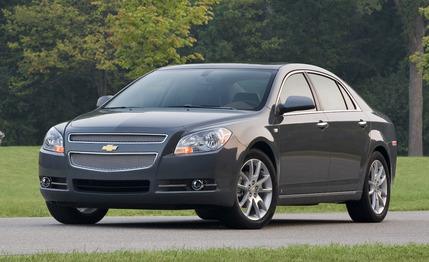
 Review
Review
Introduction
After a 10-plus-year hiatus, Chevrolet reintroduced the Chevrolet Malibu in 1997, but that Malibu failed to make a serious impact on the highly competitive and lucrative family-sedan segment—blame uncompetitive road manners and a bland appearance. A redesigned Malibu in 2004 suffered from the same flaws, and it also failed to dent the sales of the segment leaders: the Toyota Camry, the Honda Accord, and the Nissan Altima.
For 2008, Chevrolet launched a completely redesigned Malibu that bears little resemblance to the appliance-like models of the past few years. Although the new Malibu is still built off the same platform as the 2004 version, the body and the interior are completely new. The exterior styling is modern, distinctive, and more European than anything else in a Chevy showroom. The interior design is similarly well executed—a flowing instrument panel features gauges and controls that are easy to decipher and use. Most interior plastics have a rich graining and are soft to the touch. Although leather is optional, the base fabric seats feel expensive and look durable.
Available only as a sedan, the Malibu rides on the long-wheelbase version of GM’s front-wheel-drive Epsilon platform. The long 112.3-inch wheelbase gives the Malibu a spacious back seat with plenty of legroom. The Malibu’s structure gives it a quiet and solid feel, but the extra structure and size show up in the Malibu’s curb weight, which is greater than that of the Asian competition. We liked the Chevy enough to vote it onto our 2008 10Best Cars list.
Although similar in design to the independent suspension of the previous generation, the latest Malibu’s setup has been retuned to feel more responsive, competent, and refined. Chevy offers two engines in the Malibu. Base versions are powered by a DOHC 2.4-liter four-cylinder engine with 169 horsepower, and there's an uplevel DOHC 3.6-liter V-6 with 252 horsepower. Both engines offer a slick-shifting, fuel-efficient six-speed automatic; it’s standard on the LTZ model, optional on the LT, but unavailable on the LS. The alternate transmission is a four-speed automatic. The four-cylinder model can feel a bit underpowered when asked to move the heavy Malibu with any gusto. But for those concerned about fuel economy—aren’t we all nowadays?—the four-cylinder Malibu boasts excellent EPA numbers of 22 mpg city and 33 mpg highway when paired with the six-speed auto.
For 2009, the nonhybrid Malibu comes in four different trim levels (LS, 1LT, 2LT, and LTZ). LS models are exclusively four-cylinder-powered; all other trim levels come with the four-cylinder or V-6 engine. A limited-production Malibu hybrid is also available.
Major competitors to the Malibu include the Chrysler Sebring, Dodge Avenger, Ford Taurus, Honda Accord, Hyundai Sonata, Kia Optima, Mazda 6, Nissan Altima, Pontiac G6, Saturn Aura, Subaru Legacy, Toyota Camry, and Volkswagen Passat.
Verdict
The latest Malibu looks great, drives well, offers good fuel economy in four-cylinder guise, and might just be the best family sedan ever brought forth by a domestic automaker. However, it might take some time for die-hard import buyers to be convinced that the Malibu is serious competition to the Accord, Altima, and Camry.
Click here to read our full review of the Chevrolet Malibu.
Click here to read our latest comparison test involving the Chevrolet Malibu.
What’s New for 2009
The Malibu enters 2009 with minor changes. A few new paint colors are added to the palette, and the six-speed automatic transmission is now optional on 1LT four-cylinder models, standard on 2LT and LTZ four-cylinder models, and not available on the base LS. Also of note is that StabiliTrak stability control is now standard across the lineup.
Highlights and Recommendations
At the bottom of the Malibu hierarchy is the LS trim level. The base LS version comes well equipped with a full cadre of airbags and offers few options. Unfortunately, the four-cylinder-only LS trim level comes exclusively with an old-think four-speed automatic.
To get the six-speed automatic, you’ll have to move up to the 1LT trim level that starts at $21,835. Buyers of the 2LT have the option of the more-powerful V-6, but considering it commands a somewhat-hefty premium, we’d recommend trying the fuel-efficient four-cylinder before opting for the V-6.
Most buyers will be satisfied with the standard and optional equipment available on the middle trim levels (1LT and 2LT). The LTZ is the fully loaded, leather-lined model and, starting at less than $27,000, is actually some $1000 cheaper than a similar 2008 model. It’s a bit of overkill, though, as the lesser trim levels represent a better value and, as stated, offer more than enough amenities for most people.
Safety
Dual front airbags, front-seat side-impact airbags, curtain airbags, front-seatbelt pretensioners, tire-pressure monitoring, anti-lock brakes, traction control, and OnStar emergency services are standard on all Malibus, as is StabiliTrak.